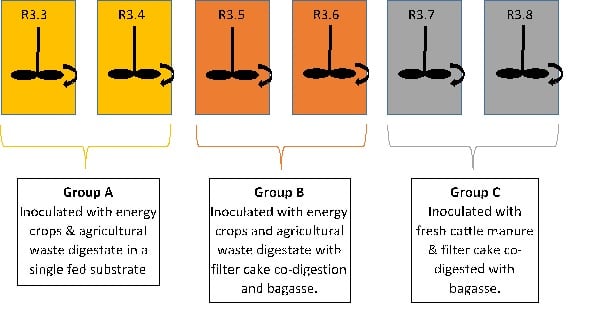A pioneer in sustainable technology, Bennamann chose the World Biogas Expo 2025 to launch onto…
Biogas production from sugar cane in Brazil
An academic team have recently analysed the best way to produce biogas from waste products in the bioethanol/ sugar industry. In Brazil, the sector has huge potential to improve the local bioeconomy and to reduce greenhouse gas emissions when treating waste products, however to be successful, the methods need to be profitable and reliable.
The team tested biogas reactors fed with sugar cane filter cake (the substance left of the filter after filtration) in a mono-digestion system and a co-digestion system with bagasse (a dry pulpy residue left after extracting juice from sugar cane). Fresh cattle manure is used as the inoculum as it is locally available; most plants in this sector are in remote locations thus making cattle manure a sensible choice. The digestate used in the system is made from energy crops and agricultural waste. Within the process the writers have noted that methanogens are very sensitive to changes in process due to their lack of function redundancy and low diversity, however, they are important to the process as they remove the fermentation product, acetate.
The experiment
The experiment consisted of six, three litre lab scale continuously stirred tank reactors in mesophilic conditions, where the bacterium grows best at a moderate temperature. The image below shows a simplified diagram of the experiment. The experiement lasted 137 days with start up taking 69 days and 70 days where the experiement is in steadystate conditions.

The results
During the experiment the slurry was tested three times by amplicon pyrosequencing. Through this testing it was found that groups B and C have similar bacterial profiles. The results found that fresh cattle manure is a reliable and efficient inoculum for co digestion with both filter cake and bagasse; which is good news from plants based in remote areas who may have access to fresh cattle manure.
The results also found that the bacterial and methanogenic communities were similar at the end of the experiment regardless of whether reactors have been inoculated with fresh cattle manure or the digestate mix of energy crop and agricultural waste.
The major Phyla (a group of biological organisms which share characteristics) were identified:
- Bacteroidetes; composed of three large classes of Gram-negative (do not retain crystal violet[1] stain), nonsporeforming, anaerobic or aerobic, and rod-shaped bacteria that are widely distributed in the environment, including in soil, sediments, and sea water, as well as in the guts and on the skin of animals.[2]
- Firmicutes; most of which have Gram-positive (retains crystal violet stain) cell wall structure.[3]
- Synergistetes; anaerobic bacteria that show Gram-negative staining and have rod/vibrioid cell shape.[4]
The process of co-digestion led to polyaccharide-degrading which is affiliated to Prevotella (a microbe cultured in the rumen and hind gut of cattle and sheep[5]) and Bacteriodes (which assist in the breakdown of food producing nutrients and energy[6]). Polyaccharide is a carbohydrate whose molecules consist of a number of sugar molecules bonded together.[7] During the first three weeks of the experiment methanogenic communities varied in co-digestion, the variation lasted five weeks with mono-digestion. The key methanogens are:
Co-digestion
- Methanosarcina; this microbe breaks down waste particles producing methane. It can survive in low pH environments and consumes acid, resulting in a higher pH environment.[8]
- Methanobacterium; is able to grow and produce methane from formate and H2/CO2 over a wide range of temperatures and at a pH of 6-8.[9]
- Methanoregulaceae; grows with acetate when H2 and CO2 are introduced to the cells.[10]
- Methanomassiliicoccus; a microbe in the Thermoplasmatales genomes which thrives in soil and sediment conditions in pH levels of 2 or below.[11] [12]
Mono-digestion
- Methanosarcina; this microbe breaks down waste particles producing methane. It can survive in low pH environments and consumes acid, resulting in a higher pH environment.[13]
- Methanobacterium; is able to grow and produce methane from formate and H2/CO2 over a wide range of temperatures and at a pH of 6-8.[14]
- Methanoregulaceae; grows with acetate when H2 and CO2 are introduced to the cells.[15]
The experiment noted that pH is the most important parameter which contributes to how the methanogenic communities were structured in the digestion processes.
The report can be found here, which explain the experiment in more detail. If you know of any research in the Anaerobic Digestion sector please email Emma Thomas with relevant information and we will aim to put any relevant research on the website.
